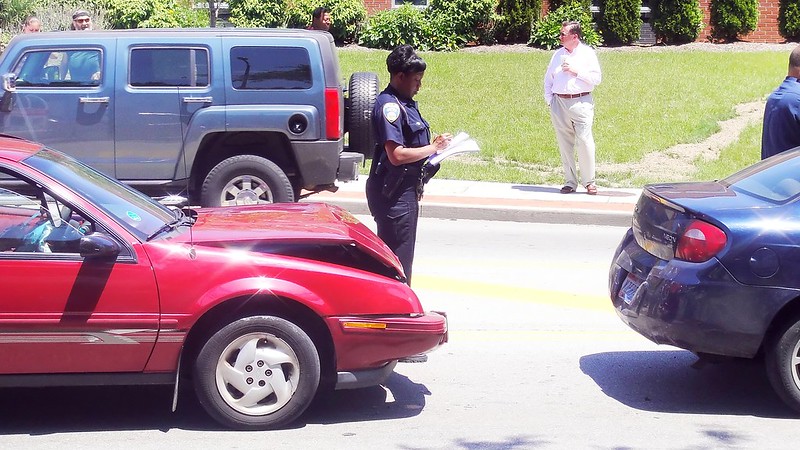Whether or not you’ve been in a car accident before, it’s easy to recognize how impactful a crash is to the involved parties. At best, accidents cause vehicular damage and increased insurance rates. At worst, they lead to injuries or even loss of life. While many factors are out of your control when you’re driving, you can avoid car accidents by learning about the most common types and how to avoid them. Read on for a comprehensive guide from American Auto Insurance to stay safer on the road.
Rear-end Collisions

Rear Ender by Mark Turnauckas is licensed with CC BY 2.0
A rear-end collision occurs when you hit a vehicle in front of you or when another car hits you from behind. It’s one of the most common types of car accidents and can cause whiplash industries. Rear-end collisions may result from a driver believing that the car in front of them is going to go through a yellow light when the car ends up stopping instead.
You can avoid this type of accident by always paying attention to the road. Eliminate distractions like texting, and never drive under the influence of drugs or alcohol. Note that even drowsy driving can slow down your reaction time. Another tip for avoiding rear-end collisions is to stay at least three seconds behind the vehicle in front of you. If you’re driving in poor weather, be sure to create even more space between your vehicle and other vehicles.
Blind-spot Accidents
A blind spot is any area around a vehicle that isn’t easily viewable from the driver’s seat. All vehicles have blind spots that you can physically turn to look at or view using special mirrors or technology, though blind spots in large SUVs and trucks are more prevalent.
While blind-spot accidents are common, they’re nearly 100% avoidable because they happen due to driver error. Be sure to know the blind spots of the car you’re driving and constantly check your mirrors to know your surroundings. Even if you have blind-spot monitoring technology, you should always physically look before turning or changing lanes.
Backing Collisions
Accidents can happen when a car backs out of a garage, driveway, or parking space. One way to avoid backing collisions is by analyzing your surroundings before getting in your car to drive away. This approach helps you recognize oncoming vehicles or obstacles that you may have missed otherwise. Other strategies include backing up in a straight line when possible and using your peripheral vision in addition to your backup camera.
Single-vehicle Accidents
While we often think of car accidents involving multiple vehicles, it’s possible for a single driver to end up in an accident on their own. Single-vehicle accidents may happen if you try to avoid debris or veer off the road because of poor driving conditions. You can avoid these situations by allocating your full focus to the road and adjusting your driving based on the weather. Additionally, be sure to follow posted speed limits.
Head-on Collisions
While head-on collisions are fairly uncommon, they’re one of the most dangerous types of accidents as they multiply the force of impact based on both cars’ motion. For instance, if you’re going 25 miles per hour and hit another vehicle head-on that’s also going 25 miles per hour, it would be the same as hitting a stationary object at 50 miles per hour. You can reduce your chance of being in a head-on collision by avoiding distractions that would cause you to leave your lane. Additionally, you can adhere to posted speed limits that help you safely get around corners.
Multi-car Collisions
Accidents often involve multiple vehicles, which can complicate insurance claims and result in more damages and injuries. While this type of accident can happen because of various factors, a common scenario is a rear-end collision triggering several other rear-end collisions. A driver can keep themselves safe from multi-car collisions by maintaining enough space between their car and the vehicle in front of them. Additionally, pay attention to all vehicles in your sight instead of only the ones closest to you. This way, you can adjust your driving if a vehicle far in front of you suddenly brakes.
Side-swipe Accidents
A side-swipe accident occurs when two vehicles traveling parallel to one another crash into each other. You can avoid this type of accident by checking your blind spots frequently and avoiding distractions. Additionally, don’t drive when you’re drowsy or under the influence.
Intersection Collisions
Intersections are one of the most common places for accidents to happen. They often occur when drivers fail to pay attention to stop lights and stop signs. Any type of accident can occur in an intersection, though rear-end collisions and T-bone side collisions are common. Keep yourself safe by abiding by traffic signs even if you think no one is around. Additionally, be sure to look both ways before advancing on a green light. Even though a green light means it should be safe for you to go, other drivers might not be as alert as you. You can also protect yourself by understanding right-of-way laws and watching for pedestrians.
Rollover Accidents
Though they’re scary, rollover accidents have surprisingly high survival rates for those who wear seatbelts. Be sure to abide by posted speed limits, as high speeds can make your vehicle more likely to roll over when you turn a corner or swerve to avoid an obstacle. You can also practice situational awareness, as it gives you time to react to another car potentially running you off the road.
We hope this guide helps you become a more alert driver and stay safe on the road. Though you can take measures to protect yourself, there’s always the possibility of getting into an accident when you step into your vehicle.
You can prepare for this unfortunate situation by getting car accident insurance. Coverage from American Auto Insurance is affordable and accessible to all drivers, including those with suspended licenses. In addition to ensuring compliance with state laws, obtaining car insurance offers financial protection and helps you recover after an emotionally and physically taxing car accident. Contact us today by calling 773-286-3500 to get the policy you need.


